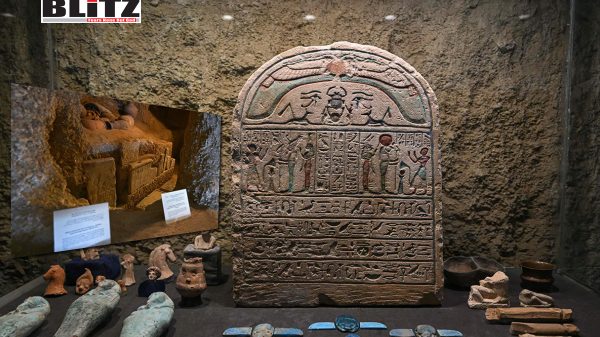Egypt unveils archaeological wonders in Luxor discovery
- Update Time : Friday, January 10, 2025

On January 8, Egypt revealed new archaeological discoveries, including 4,000-year-old tombs and intricate artwork from the reign of Queen Hatshepsut. These findings were unearthed at the ancient necropolis of Thebes, specifically in the Deir al-Bahari area in Luxor, a site renowned for its historical significance. The discoveries mark a significant milestone in Egyptology and highlight the rich cultural heritage of ancient Egypt.
The excavation, led by renowned Egyptologist Zahi Hawass in collaboration with Egypt’s Supreme Council of Antiquities, has been ongoing for three years. The artefacts discovered date from the 15th dynasty (1650-1550 BC) to the powerful 18th dynasty (1550-1292 BC), an era that witnessed the reign of iconic rulers such as Queen Hatshepsut and King Tutankhamun.
Among the most significant findings is an intact portion of the foundation for the valley temple within Queen Hatshepsut’s funerary complex. The complex features intricate bas-reliefs and vividly colored inscriptions, showcasing the artistic mastery of ancient Egyptian craftsmen. These decorated blocks depict sacred rituals performed by Queen Hatshepsut and her successor, Thutmose III.
Zahi Hawass, who personally unveiled the discoveries, expressed his awe at the artwork, describing it as “the most beautiful scene I have ever seen in my life.” He emphasized the significance of the find, stating, “This is the first time that we have a final programme of the decoration of a temple dating to the 18th dynasty.”
In addition to the temple’s decorations, archaeologists discovered ceremonial tools inscribed with Queen Hatshepsut’s name beneath the temple’s foundation. These tools provide insight into the rituals and ceremonies performed during her reign.
The excavation also revealed rock-cut tombs belonging to high-ranking officials from the Middle Kingdom and the 18th dynasty. One particularly notable discovery was the tomb of the “Overseer of the Palace” of Queen Tetisheri, the grandmother of King Ahmose I. Ahmose I is historically significant for expelling the Hyksos, a Western Asian people who controlled the Nile Delta for nearly a century.
Additional finds include burial shafts containing wooden coffins adorned with a feather emblem associated with the 17th dynasty, as well as children’s graves that contained toys, shedding light on the lives of ancient Egyptian families.
The timing of these discoveries aligns with Egypt’s broader efforts to rejuvenate its tourism sector, a crucial source of foreign currency for the country’s struggling economy. In 2023, Egypt welcomed 15.7 million tourists and aims to attract 18 million visitors in 2024. The unveiling of these archaeological wonders is expected to bolster interest in Egypt’s rich history and drive tourism to the region.
Luxor, often referred to as the “world’s greatest open-air museum,” has long been a focal point for archaeological research and tourism. The city’s numerous temples, tombs, and monuments attract millions of visitors each year. The latest discoveries further enhance Luxor’s reputation as a treasure trove of ancient history and culture.
The findings also highlight the legacy of Queen Hatshepsut, one of ancient Egypt’s most influential rulers. Hatshepsut, who reigned during the 18th dynasty, is often celebrated for her ambitious building projects, including her iconic mortuary temple at Deir al-Bahari. She was a pioneering female pharaoh who defied gender norms by adopting the full regalia of a male king, including a false beard.
The valley temple within her funerary complex, now partially uncovered, is a testament to her architectural vision and the grandeur of her reign. The intricate artwork and ceremonial tools discovered at the site provide valuable insights into the religious practices and cultural achievements of her time.
The recent discoveries in Luxor not only shed light on the lives and rituals of ancient Egyptians but also underscore the importance of preserving and studying archaeological sites. The well-preserved bas-reliefs and inscriptions offer a rare glimpse into the artistic and cultural achievements of the 18th dynasty, while the tombs and burial shafts provide valuable information about the social hierarchy and funerary practices of the time.
Moreover, these findings contribute to a broader understanding of Egypt’s historical timeline, linking the Middle Kingdom, the Second Intermediate Period, and the New Kingdom. The tomb of the “Overseer of the Palace” of Queen Tetisheri, for example, connects the narrative of the Hyksos expulsion to the dawn of the 18th dynasty, a transformative period in Egyptian history.
The ongoing excavation at Deir al-Bahari and other sites in Luxor holds great promise for future discoveries. Egypt’s commitment to preserving its cultural heritage and promoting archaeological research is evident in its collaboration with international experts and institutions. These efforts not only enhance our understanding of ancient civilizations but also contribute to Egypt’s cultural tourism industry.
As Egypt continues to unveil its ancient treasures, the world remains captivated by the mysteries and marvels of its storied past. The recent discoveries in Luxor serve as a reminder of the enduring legacy of ancient Egypt and its profound impact on human history and culture.














Leave a Reply